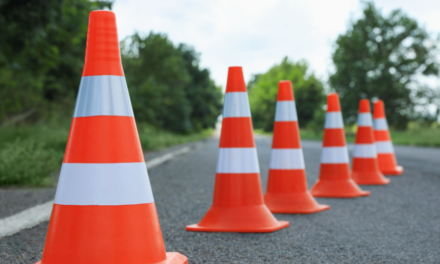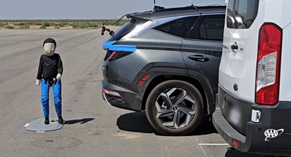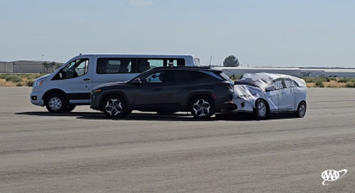
Reverse AEB: Proceed with Caution!
AAA research finds flaws in vehicle technology designed to brake for you while backing up
TAMPA, FL – New AAA research reminds drivers to not put too much trust in their vehicle technology, especially when driving in reverse. AAA studied the effectiveness of technology designed to prevent drivers from backing into a pedestrian or approaching vehicle.
“Although this technology has proven to significantly reduce rear-end collisions, they are not foolproof,” said Mark Jenkins, spokesman, AAA – The Auto Club Group. “Our testing resulted in collisions with mock vehicles and pedestrians. So, drivers should remain alert and not become overly reliant on the technology.”
AAA studied four vehicles that combine Reverse Automatic Emergency Braking (Reverse AEB) and rear cross traffic mitigation. These systems are designed to detect rear cross-traffic and automatically apply brakes to avoid colliding with other cars, pedestrians, cyclists or stationary objects.
Research Overview
AAA conducted primary research in a closed-course environment to understand the performance of reverse AEB systems with rear cross traffic mitigation in challenging scenarios. Read the full report.
AAA Engineers wanted to answer two questions:
- How do evaluated reverse AEB systems with rear cross traffic mitigation perform when backing out of a parking space into path of oncoming vehicle with an adjacent parked vehicle obstructing view?
- How do evaluated reverse AEB systems perform when encountering a static simulated child pedestrian behind the vehicle?
Four popular 2023 model year vehicles equipped with reverse AEB with rear cross traffic mitigation were evaluated within this research. Only reverse AEB systems with the ability to detect and automatically brake for rear cross traffic were eligible for testing.
Key Findings:
- Scenario A (backing out of a parking space into the path of an oncoming vehicle, with the test car perpendicularly parked)
- Scenario B (backing out of a parking space into the path of an oncoming vehicle, with the test car in an angled parking spot)
- Aggregated Results for Scenario A and Scenario B: The systems automatically applied brakes in 26 of 40 test runs (65%) and successfully prevented collision in 1 of 40 test runs (2.5%).
- Scenario C (backing out of a parking space into the path of a stationary child pedestrian)
- Results for Scenario C: The systems automatically applied brakes in 15 of 20 test runs (75%) and successfully prevented collision in 10 of 20 test runs (50%)
Analyzing Reverse Collisions and the Heightened Risk for Child Pedestrians
Reverse AEB is reported to be the most effective ADAS in terms of property damage liability claim reductions, while injury and fatality reductions were less pronounced than that of front AEB. Backing collisions usually happen between vehicles at a significantly lower speed resulting in a lower injury and fatality rate relative to collisions that may be mitigated by front AEB. However, children are particularly susceptible to back-over incidents in driveways and parking lots.
NHTSA estimates that every year, there are approximately 210 fatalities and 15,000 injuries caused by backover collisions. Of those fatalities, approximately 31 percent are children under five years old. In addition to vehicle-to-vehicle collisions, it is important to evaluate the effectiveness of these systems in preventing or mitigating collisions with pedestrians, especially children.
AAA’s Advice for Drivers
- Drivers should not rely on reverse AEB systems to prevent collisions when backing up. Even in the pedestrian scenario, with a stationary target and an unobstructed view throughout the test run, collision was only prevented on 50% of runs.
- Drivers should remain fully aware of their surroundings, utilize backup cameras to enhance their awareness, and back up cautiously.
Drivers should understand how these safety features work and give them the best chance to provide benefit.
- These systems rely on sensors that are typically mounted on the rear bumper area of the vehicle.
- When backing up with an obstructed view, drivers should back up cautiously and pause once the rear of their vehicle has cleared the obstruction to allow for these sensors to detect cross traffic. This will give the system more time to detect a potential collision and bring the vehicle to a stop.
Check out Fixing Advanced Vehicle Systems Makes Up Over One-Third of Repair Costs Following a Crash.
Methodology
In partnership with the Automobile Club of Southern California’s Automotive Research Center, AAA selected four popular 2023 model year vehicles equipped with reverse AEB with rear cross traffic mitigation. Only reverse AEB systems with the ability to detect and automatically brake for rear cross traffic were eligible for testing. It was determined that all test vehicles would be small to medium SUVs due to the popularity of these categories. The “2023 Hyundai Tucson Hybrid”, The “Limited AWD 2023 Lexus RX 350 “Premium,” The “2023 Mazda CX-30 2.5 Turbo AWD “Premium Plus Package” and the “2023 Volkswagen Tiguan 2.0T “SEL R-Line.”
Please refer to the full report for methodology details, including specific testing equipment and test track characteristics.
About AAA – The Auto Club Group
The Auto Club Group (ACG) is the second largest AAA club in North America with more than 13 million members across 14 U.S. states, the province of Quebec and two U.S. territories. ACG and its affiliates provide members with roadside assistance, insurance products, banking and financial services, travel offerings and more. ACG belongs to the national AAA federation with more than 64 million members in the United States and Canada. AAA’s mission is to protect and advance freedom of mobility and improve traffic safety. For more information, get the AAA Mobile app, visit AAA.com, and follow on Facebook, Twitter and LinkedIn.
Angela Small
Radio Production Assistant

















